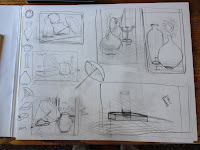 When I got to drawing class last week, our teacher, Irina, was putting the finishing touches on a still life: an umbrella, a book, a teapot, a candlestick, a hat, two vases (tall and short), and a wreath of dried flowers arranged against the backdrop of a brocade cloth.
When I got to drawing class last week, our teacher, Irina, was putting the finishing touches on a still life: an umbrella, a book, a teapot, a candlestick, a hat, two vases (tall and short), and a wreath of dried flowers arranged against the backdrop of a brocade cloth.I wasn’t the only one who freaked out at the prospect of trying to draw it.
But (Thank God!) the lesson wasn’t about trying to draw all those objects in perspective; it was about choosing what to draw.
“Each person is drawn to different objects,” Irina said. “Choose the objects that interest you, arrange them in ways that please you. Experiment.”
We watched her draw six boxes, some with a vertical orientation, some horizontal, on a big piece of drawing paper, then watched her choose and arrange a set of objects in each one. A vase, the umbrella, the teapot. The candlestick, the book, the wreath.
She taught as she drew: always an uneven number, no object right in the middle, remember the rule of thirds, there must be a sense of story. I loved her little pictures, how deftly she drew them. How, once a drawing was in place, she cleverly rearranged the lines of the box to frame the objects in the most effective way.
The series of drawings on the big page looked like the storyboard of an artist’s sketchbook, a visual representation of Irina’s thinking, her process—and I had another one of those light bulb moments.
Choosing and arranging objects to create a still life is exactly like choosing and arranging the elements of the story. The world offers up objects; the choices you make and how you combine objects or scenes to make a painting or a story are guided by who you are.
While I was still in the thrall of this new piece of information about the creative process, Irina drew a teapot in one of the boxes, then stopped and looked at. “The teapot needs some gloves,” she said, and drew a pair beside it.”
At which point the drawing took on a life of its own, just as a story does when the characters come alive and start to tell you what to do.
Holy cow! I thought.
Sketching is like freewriting: you start with what you have before you and wait for something interesting to happen. It’s like revision, too: you try and fail at capturing something you feel until the objects (some real, some imagined) fall into their right places.
Later, drawing my own little compositions, there was the same pleasure I often feel, tinkering with the bits and pieces of a story; the same struggle to let go of what’s already there and trust my right brain to supply a piece of the puzzle.
“Too vertical!” Irina said of one of my drawings. “You have the two candlesticks, why not a third—but not the same. She drew a little candelabrum in the foreground, changed some lines, added a window.
She regarded the flowers I’d added to the vase. “Break the flower!” she said and, in a stroke, made a flower whose long stem swooped down and pulled the objects more closely together.
I left class that day, my mind reeling.
The exercise had been a lot like shuffling scenes on index cards to explore sequence.
Like considering all the points of view from which a story might be told.
Like regarding everything you’ve ever written as a rich mine from which you might pluck an abandoned character to make use of him in another story.
I pondered what Irina meant when she said, “Look for the story,” and it occurred to me that, while a painting might present the suggestion of a traditional narrative, the actual story of a painting is in how color, light, line, shape, proportion, and perspective of a series of objects connect visually to say something about themselves and about the artist who arranged and rendered them in that particular way.
Maybe.
I’m still not sure about so many things about how paintings are made and how they work. But it is so cool to be challenged by this wonderful drawing class, to be…
learning.




